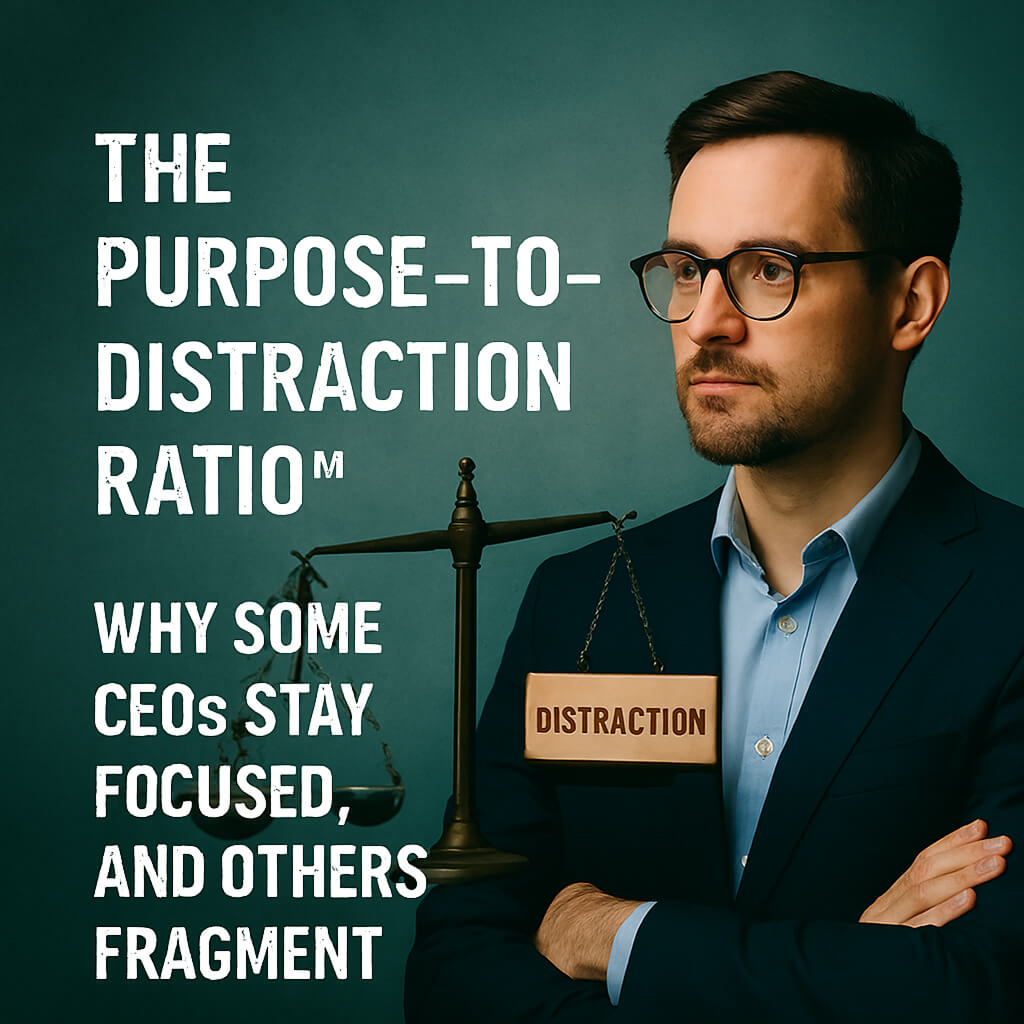After a decade coaching CEOs across the globe, I’ve observed a subtle but powerful trait that distinguishes transformative leaders: a high Purpose-to-Distraction Ratio™.
It’s a framework I’ve developed to explain why some leaders build enduring legacies while others, despite talent, become mired in fragmentation.
Once you understand it, it reshapes how you see leadership.
Purpose is clarity. Distraction is the leak.
Every leader begins with a clear purpose: a vision that fuels their drive to create, innovate, or serve.
But the modern leadership landscape is a minefield of distractions: shareholder pressures, internal politics, social media optics, and even the seductive pull of short-term wins.
Over time, these leaks erode clarity, leaving leaders reactive, scattered, and disconnected from their core mission.
What separates the exceptional is their discipline to protect purpose from distraction, not just occasionally, but relentlessly.
What is the Purpose-to-Distraction Ratio™?
The Purpose-to-Distraction Ratio™ measures how much of a leader’s energy, time, and decisions align with their core mission versus how much is siphoned off by distractions.
It’s not about personality or charisma; it’s a deliberate practice, honed through choices that prioritize long-term impact over fleeting noise.
Distractions aren’t always external.
Psychological traps like self-doubt, perfectionism, or the need for validation can be just as corrosive.
Systemic factors, misaligned incentives, bloated processes, or toxic cultures, compound the problem.
A high ratio requires both personal resolve and structural alignment.
What Does It Look Like in Action?
Consider Piyush Gupta, who led DBS Bank as CEO from 2009 until his retirement in March 2025. During his tenure, Gupta transformed DBS into a global digital powerhouse, integrating over 800 AI models across 350 use cases, generating over SGD $1 billion in economic impact by 2025.
He didn’t just delegate innovation. With no AI experts in banking to lean on, Gupta studied AI himself, entered an Amazon AI competition, and hired data scientists to run 1,000 experiments yearly.
Yet Gupta faced distractions: IT outages in 2021 and 2023 drew regulatory scrutiny and required personal accountability, including a pay cut.
Despite these setbacks, he maintained a Purpose-to-Distraction Ratio™ I’d estimate at ~90%, staying focused on long-term digital transformation over short-term crises. Post-retirement, his appointment as Deputy Chairman of Keppel in July 2025 shows his clarity endures.
Contrast this with Yvon Chouinard, Patagonia’s founder, whose ratio approaches 100%. Chouinard’s purpose- building a business that serves the planet, never wavered.
He rejected IPOs, avoided performative growth, and in 2022, transferred Patagonia’s ownership to a trust and nonprofit to fund environmental causes.
His clarity wasn’t just personal; it reshaped Patagonia’s culture, earning unwavering trust from employees and customers.
[See how Gupta and Chouinard’s Purpose-to-Distraction Ratios™ drove their impact.]
Minimize image
Edit image
Delete image
Why It Matters Beyond the C-Suite
A high Purpose-to-Distraction Ratio™ isn’t just for CEOs. It’s a discipline for anyone leading a team, project, or career.
When leaders prioritize clarity, they model it for their organizations. Teams become more aligned, decisions more coherent, and stakeholders more trusting.
Research shows that purpose-driven companies outperform competitors by 6–10% in long-term returns, as employees and customers gravitate toward authenticity.
Conversely, a low ratio creates a ripple effect: fragmented focus leads to misaligned priorities, eroded morale, and diminished impact. Boards notice. Teams disengage. The organization drifts.
How to Measure Your Ratio
Here’s a self-assessment I use with CEOs to gauge their Purpose-to-Distraction Ratio™:
Purpose Drivers (Score 1–10 for each)
• I have a clear mission that guides my work.
• My time allocation reflects my stated priorities.
• My decisions prioritize long-term vision over short-term pressures.
• I carve out space for strategic thinking and deep conversations.
• I feel centered, not stretched across competing demands.
Distraction Drivers (Score 1–10 for each)
• I react to external expectations or urgent but unimportant tasks.
• I prioritize appearances or validation over meaningful progress.
• I spend time on activities that don’t advance my mission.
• I compromise my values for convenience or quick wins.
• I feel busy but not impactful.
Your Formula:
Add your Purpose scores (max 50) and Distraction scores (max 50). Calculate:
(Purpose Total ÷ (Purpose Total + Distraction Total)) × 100 = Your Ratio (%)
• 80–100%: You’re a beacon of clarity. Sustain it.
• 60–79%: You’re focused but leaking energy. Refocus.
• 40–59%: Fragmentation is taking a toll. Recalibrate.
• Below 40%: Distraction dominates. It’s time to realign.
Raising Your Ratio
Elevating your Purpose-to-Distraction Ratio™ requires intention:
• Audit Your Time: Map your calendar to your mission. Eliminate or delegate low-impact tasks.
• Build Guardrails: Set boundaries against distractions, like limiting reactive meetings or curating your media diet.
• Align Your Environment: Surround yourself with people and systems that reinforce your purpose, not dilute it.
• Reflect Regularly: Schedule time to revisit your mission and assess whether your actions align.
A Call to Lead with Clarity
The best leaders don’t just work harder; they work with intention.
A high Purpose-to-Distraction Ratio™ sharpens your focus, galvanizes your team, and builds a legacy that lasts.
Whether you’re a CEO or an aspiring leader, the question is the same: What’s your ratio, and how will you raise it?
Take the self-assessment and share your score in the comments or DM me to explore how to lead with greater clarity.
Let’s build a community of purpose-driven leaders, together.
Purpose-to-Distraction Ratio™ is a proprietary concept developed by Catherine Li-Yunxia (Transforming leaders, Moving the world) as part of the Integral CEO methodology. All rights reserved.
–By Catherine Li-Yunxia
Top Global CEO Coach & C-Suite Coach 2023 | Keynote Speaker on Human Leadership | Author of Integral CEO

